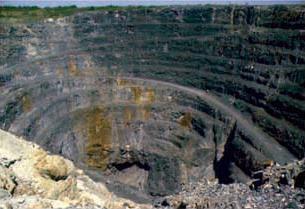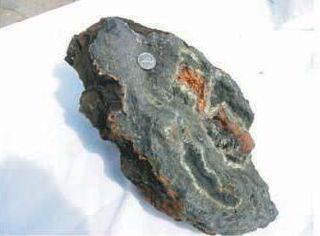Related Research Articles

In biochemistry, chemosynthesis is the biological conversion of one or more carbon-containing molecules and nutrients into organic matter using the oxidation of inorganic compounds or ferrous ions as a source of energy, rather than sunlight, as in photosynthesis. Chemoautotrophs, organisms that obtain carbon from carbon dioxide through chemosynthesis, are phylogenetically diverse. Groups that include conspicuous or biogeochemically-important taxa include the sulfur-oxidizing Gammaproteobacteria, the Campylobacterota, the Aquificota, the methanogenic archaea, and the neutrophilic iron-oxidizing bacteria.

A hydrothermal vent is a fissure on the seabed from which geothermally heated water discharges. They are commonly found near volcanically active places, areas where tectonic plates are moving apart at mid-ocean ridges, ocean basins, and hotspots. Hydrothermal deposits are rocks and mineral ore deposits formed by the action of hydrothermal vents.

Volcanogenic massive sulfide ore deposits, also known as VMS ore deposits, are a type of metal sulfide ore deposit, mainly copper-zinc which are associated with and created by volcanic-associated hydrothermal events in submarine environments.

Mirocaris is a genus of shrimp associated with hydrothermal vents. Sometimes considered the only genus of the family Mirocarididae, Mirocaris is usually placed in the family Alvinocarididae. The genus contains two species, M. fortunata and M. indica; the former species M. keldyshi is now considered synonymous with M. fortunata. The two species are found in different oceans, and can be distinguished by the pattern of setation on the claw of the first pereiopod.
Sulfur-reducing bacteria are microorganisms able to reduce elemental sulfur (S0) to hydrogen sulfide (H2S). These microbes use inorganic sulfur compounds as electron acceptors to sustain several activities such as respiration, conserving energy and growth, in absence of oxygen. The final product or these processes, sulfide, has a considerable influence on the chemistry of the environment and, in addition, is used as electron donor for a large variety of microbial metabolisms. Several types of bacteria and many non-methanogenic archaea can reduce sulfur. Microbial sulfur reduction was already shown in early studies, which highlighted the first proof of S0 reduction in a vibrioid bacterium from mud, with sulfur as electron acceptor and H
2 as electron donor. The first pure cultured species of sulfur-reducing bacteria, Desulfuromonas acetoxidans, was discovered in 1976 and described by Pfennig Norbert and Biebel Hanno as an anaerobic sulfur-reducing and acetate-oxidizing bacterium, not able to reduce sulfate. Only few taxa are true sulfur-reducing bacteria, using sulfur reduction as the only or main catabolic reaction. Normally, they couple this reaction with the oxidation of acetate, succinate or other organic compounds. In general, sulfate-reducing bacteria are able to use both sulfate and elemental sulfur as electron acceptors. Thanks to its abundancy and thermodynamic stability, sulfate is the most studied electron acceptor for anaerobic respiration that involves sulfur compounds. Elemental sulfur, however, is very abundant and important, especially in deep-sea hydrothermal vents, hot springs and other extreme environments, making its isolation more difficult. Some bacteria – such as Proteus, Campylobacter, Pseudomonas and Salmonella – have the ability to reduce sulfur, but can also use oxygen and other terminal electron acceptors.

Campylobacterota are a phylum of bacteria. All species of this phylum are Gram-negative.

Seafloor massive sulfide deposits or SMS deposits, are modern equivalents of ancient volcanogenic massive sulfide ore deposits or VMS deposits. The term has been coined by mineral explorers to differentiate the modern deposit from the ancient.

The Explorer Ridge is a mid-ocean ridge, a divergent tectonic plate boundary located about 241 km (150 mi) west of Vancouver Island, British Columbia, Canada. It lies at the northern extremity of the Pacific spreading axis. To its east is the Explorer Plate, which together with the Juan de Fuca Plate and the Gorda Plate to its south, is what remains of the once-vast Farallon Plate which has been largely subducted under the North American Plate. The Explorer Ridge consists of one major segment, the Southern Explorer Ridge, and several smaller segments. It runs northward from the Sovanco Fracture Zone to the Queen Charlotte Triple Junction, a point where it meets the Queen Charlotte Fault and the northern Cascadia subduction zone.

Chrysomallon squamiferum, commonly known as the scaly-foot gastropod, scaly-foot snail, sea pangolin, or volcano snail is a species of deep-sea hydrothermal-vent snail, a marine gastropod mollusc in the family Peltospiridae. This vent-endemic gastropod is known only from deep-sea hydrothermal vents in the Indian Ocean, where it has been found at depths of about 2,400–2,900 m (1.5–1.8 mi). C. squamiferum differs greatly from other deep-sea gastropods, even the closely related neomphalines. In 2019, it was declared endangered on the IUCN Red List, the first species to be listed as such due to risks from deep-sea mining of its vent habitat.

The Endeavour Hydrothermal Vents are a group of hydrothermal vents in the north-eastern Pacific Ocean, located 260 kilometres (160 mi) southwest of Vancouver Island, British Columbia, Canada. The vent field lies 2,250 metres (7,380 ft) below sea level on the northern Endeavour segment of the Juan de Fuca Ridge. In 1982, dredged sulfide samples were recovered from the area covered in small tube worms and prompted a return to the vent field in August 1984, where the active vent field was confirmed by HOV Alvin on leg 10 of cruise AII-112.
Sulfurimonas is a bacterial genus within the class of Campylobacterota, known for reducing nitrate, oxidizing both sulfur and hydrogen, and containing Group IV hydrogenases. This genus consists of four species: Sulfurimonas autorophica, Sulfurimonas denitrificans, Sulfurimonas gotlandica, and Sulfurimonas paralvinellae. The genus' name is derived from "sulfur" in Latin and "monas" from Greek, together meaning a “sulfur-oxidizing rod”. The size of the bacteria varies between about 1.5-2.5 μm in length and 0.5-1.0 μm in width. Members of the genus Sulfurimonas are found in a variety of different environments which include deep sea-vents, marine sediments, and terrestrial habitats. Their ability to survive in extreme conditions is attributed to multiple copies of one enzyme. Phylogenetic analysis suggests that members of the genus Sulfurimonas have limited dispersal ability and its speciation was affected by geographical isolation rather than hydrothermal composition. Deep ocean currents affect the dispersal of Sulfurimonas spp., influencing its speciation. As shown in the MLSA report of deep-sea hydrothermal vents Campylobacterota, Sulfurimonas has a higher dispersal capability compared with deep sea hydrothermal vent thermophiles, indicating allopatric speciation.
Persephonella guaymasensis is a thermophilic, hydrogen-oxidizing microaerophile first isolated from a deep-sea hydrothermal vent. It is strictly chemolithoautotrophic, microaerophilic, motile, 2-4 micrometres in size, rod-shaped, Gram-negative and non-sporulating. Its type strain is EX-H2T.
Microbacterium hydrothermale is a Gram-positive, aerobic, rod-shaped and non-motile bacterium from the genus Microbacterium which has been isolated from hydrothermal sediments from the Indian Ocean.
Fulvimarina manganoxydans is a Gram-negative and aerobic from the genus of Fulvimarina which has been isolated from a Hydrothermal vent from the Indian Ocean.
Caloranaerobacter is a Gram-negative, thermophilic, anaerobic and chemoorganotrophic bacterial genus from the family of Clostridiaceae.
Caloranaerobacter ferrireducens is a Gram-negative, thermophilic, anaerobic, iron-reducing and motile bacterium from the genus of Caloranaerobacter which has been isolated from hydrothermal sulfide deposits from the East Pacific Rise.
Janibacter indicus is a species of Gram positive, aerobic, bacterium. The species was initially isolated from hydrothermal sediment from the Indian Ocean. The species was first described in 2014, and the species named refers to the Indian Ocean.
Paramaledivibacter caminithermalis is a species of bacteria in the family Peptostreptococcaceae. Clostridium caminithermale has been reclassified to Paramaledivibacter caminithermalis. Paramaledivibacter caminithermalis has been isolated from a deep-sea hydrothermal vent from the Atlantic Ocean Ridge.
Acidimangrovimonas indica is a Gram-negative, strictly aerobic, chemoheterotrophic and motile bacterium from the genus of Acidimangrovimonas which has been isolated from a deep-sea hydrothermal vent from the Southwest Indian Ridge in China.
Wocania ichthyoenteri is a Gram-negative, strictly aerobic and rod-shaped bacterium from the genus of Wocania which has been isolated from the intestine of the fish Paralichthys olivaceus.
References
- 1 2 "Species: Wocania indica". LPSN.DSMZ.de.
- 1 2 He, Yang; Zeng, Xiang; Xiong, Jinbo; Lai, Qiliang; Li, Jianyang; Shao, Zongze (1 October 2020). "Wocania indica gen. nov., sp. nov., isolated from deep sea hydrothermal sulfide in the northwest Indian Ocean, and proposal to reclassify Flaviramulus ichthyoenteri as Wocania ichthyoenteri comb. nov". International Journal of Systematic and Evolutionary Microbiology. 70 (10): 5488–5496. doi: 10.1099/ijsem.0.004439 . PMID 32886593. S2CID 221503791.
- ↑ "Wocania indica". www.uniprot.org.